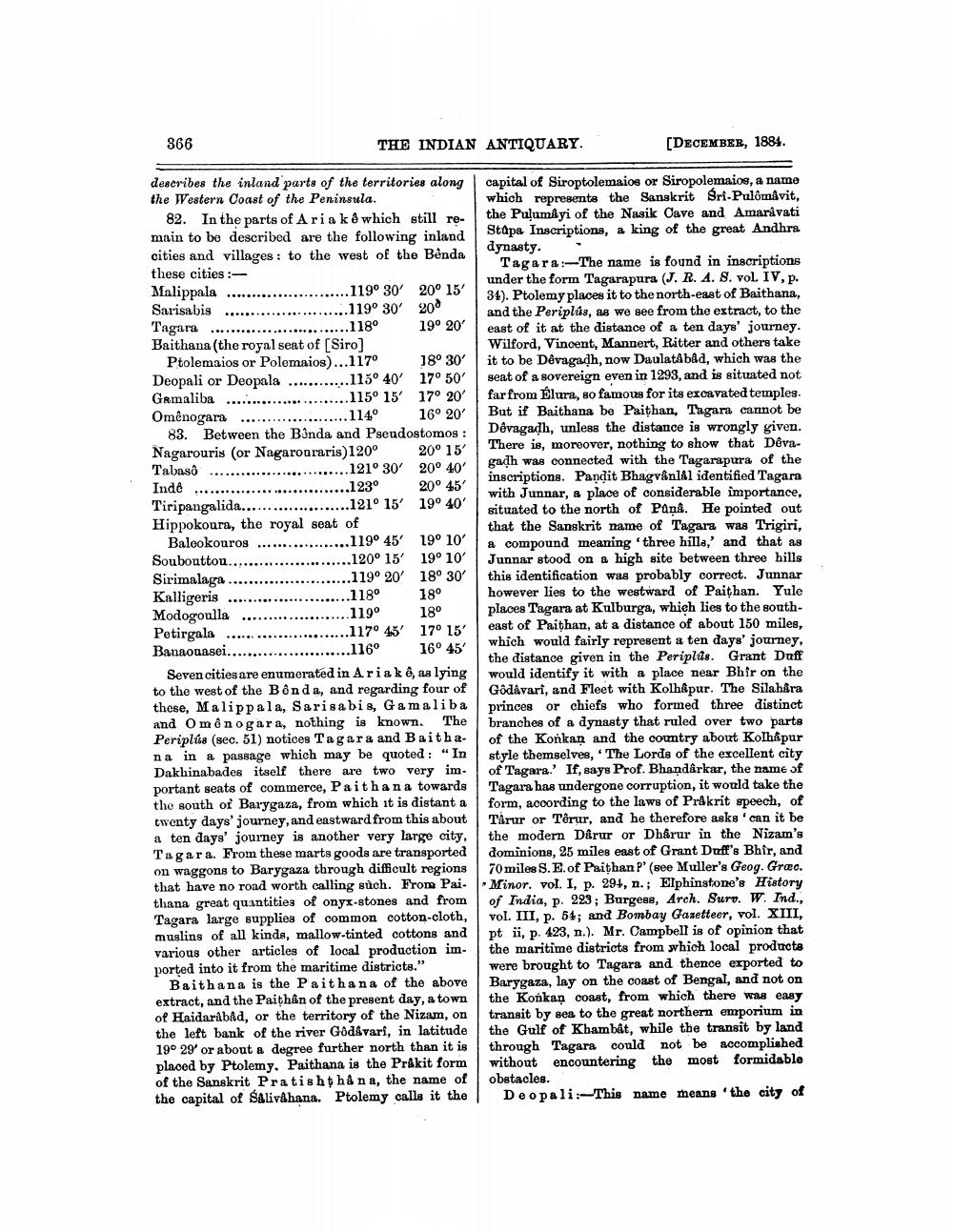________________
866
THE INDIAN ANTIQUARY.
[DECEMBER, 1884.
describes the inland parts of the territories along the Western Coast of the Peninsula.
82. In the parts of Aria k ê which still remain to be described are the following inland cities and villages : to the west of the Benda these cities :Malippala ..........................119° 30' 20° 15' Sarisabis ........................119° 30' 200 Tagara ........
...............118° 199 20 Baithana (the royal seat of [Siro]
Ptolemaios or Polemaios)...117° 18° 30 Deopali or Deopala ............115° 40' 17° 50' Gamaliba ........................115° 15' 17° 20' Omênogara ..................... 114° 16° 20'
83. Between the Bända and Pseudostomos : Nagarouris (or Nagarooraris) 120° 20° 15' Tabasô ...........
.............. 121° 30' 20° 40' Indo ...........................123° 20° 45' Tiripangalida.....................121° 15' 19° 40' Hippokoura, the royal seat of
Balookouros ...................119° 45' 19° 10' Soubouttou.........................120° 15' 19° 10' Sirimalaga ........................119° 20 18° 30 Kalligeris ........................118° 18° Modogoulla .....................119° 18° Petirgala ........................117° 45' 17° 15' Banaouasei........................116° 16° 45'
Seven cities are enumerated in Ariak 6, aa lying to the west of the Bênda, and regarding four of these, Malippala, Sarisabis, Gamaliba and Omônogara, nothing is known. The Periplús (sec. 51) notices Tagara and Baithana in a passage which may be quoted : “In Dakhinabades itself there are two very im. portant seats of commerce, Paithana towards the south or Barygaza, from which it is distant a twenty days' journey, and eastward from this about a ten days' journey is another very large city, Tagara. From these marts goods are transported on waggons to Barygaza through difficult regions that have no road worth calling such. From Pai. thana great quantities of onyx.stones and from Tagara large supplies of common cotton-cloth, muslins of all kinds, mallow-tinted cottons and various other articles of local production imported into it from the maritime districts."
Baithana is the Paithana of the above extract, and the Paithân of the present day, a town of Haidarabad, or the territory of the Nizam, on the left bank of the river Godavari, in latitude 19° 29' or about a degree further north than it is placed by Ptolemy. Paithana is the Pr&kit form of the Sanskrit Pratishthana, the name of the capital of salivahana. Ptolemy calls it the
capital of Siroptolemaios or Siropolemaios, a name which represents the Sanskrit Sri-Pulómavit, the Pulumáyi of the Nasik Cave and Amarivati Stapa Inscriptions, a king of the great Andhra dynasty. .
Tagara:-The name is found in inscriptions under the form Tagarapura (J. R. 4. 8. voL IV, p. 34). Ptolemy places it to the north-east of Baithana, and the Periplús, as we see from the extract, to the east of it at the distance of a ten days' journey. Wilford, Vincent, Mannert, Ritter and others take it to be Devagadh, now Daulatåbåd, which was the seat of a sovereign even in 1293, and is situated not far from Blura, so famous for its excavated temples. But if Baithana be Paithan, Tagara camot be Dêvagadh, unless the distance is wrongly given. There is, moreover, nothing to show that Dévagadh was connected with the Tagarapura of the inscriptions. Pandit Bhagvânlal identified Tagara with Junnar, & place of considerable importance, situated to the north of Pans. He pointed out that the Sanskrit name of Tagara was Trigiri, a compound meaning 'three hills,' and that as Junnar stood on a high site between three hills this identification was probably correct. Junnar however lies to the westward of Paithan. Yule places Tagara at Kulburga, whiệh lies to the southeast of Paithan, at a distance of about 150 miles, which would fairly represent a ten days' journey, the distance given in the Periplus. Grant Duff would identify it with a place near Bhir on the Godavart, and Fleet with Kolhậpur. The Silahira princes or chiefs who formed three distinct branches of a dynasty that ruled over two parts of the Końkan and the country about Kolhapur style themselves, The Lords of the excellent city of Tagara.' If, says Prof. Bhandarkar, the name of Tagara has undergone corruption, it would take the form, according to the laws of Prakrit speech, of Târur or Törur, and he therefore asks 'can it be the modern Darur or Dharur in the Nizam's dominions, 25 miles east of Grant Duff's Bhir, and 70 miles S.E.of Paithan P' (see Muller's Geog. Græc. Minor. vol. I, p. 297, n.; Elphinstone's History of India, p. 223; Burgess, Arch. Suro. W. Ind. vol. III, p. 54; and Bombay Gazetteer, vol. XIII, pt ii, p. 423, n.). Mr. Campbell is of opinion that the maritime districts from which local products were brought to Tagara and thence exported to Barygaza, lay on the coast of Bengal, and not on the Konkan coast, from which there was easy transit by sea to the great northern emporium in the Gulf of Khambat, while the transit by land through Tagara could not be accomplished without encountering the most formidable obstacles.
Deopali: This name means the city of




